Erechthias flavistriata, the sugarcane bud moth, is a moth of the family Tineidae. It was described by Lord Walsingham in 1907 from Hawaii, but is probably an introduced species. It is found in large parts of the Pacific Rim including the Marquesas, Rapa Iti, Fiji, the New Hebrides, the Kermadec Islands, the Solomons, Java and Malaya. It has been spread widely by man and probably has travelled to many islands throughout much of the Pacific in the canoes of the native peoples.
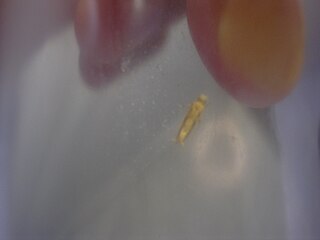
Erechthias minuscula, the erechthias clothes moth, is a moth of the family Tineidae. It was first described by Lord Walsingham in 1897. It is widespread and has been recorded from Africa, Sri Lanka, Java, Australia, the Caroline Islands, Fiji, Samoa, the Marquesas, the West Indies, Hawaii and Florida.
Erechthias penicillata is a moth of the family Tineidae. It was first described by Otto Herman Swezey in 1909. It is found in the Pacific region, including French Polynesia and Hawaii.
Erechthias kerri is a moth of the family Tineidae. It was first described by Otto Swezey in 1926. It is found in the Pacific region, including the French Frigate Shoals, Lisianski, Laysan, the Pearl and Hermes Reef, Johnston Island and Hawaii.

Erechthias simulans is a species of fungus moth. It is here considered to belong to the somewhat controversial type genus of its subfamily Erechthiinae, though even fairly recently some authors have proposed to retain other genera such as Decadarchis separate from Erechthias. Decadarchis, with E. simulans as type species, would in fact contain this moth and its closest relatives, regardless whether it is recognized as full genus or as subgenus. These relatives are generally held to be a group of mainly Polynesian species. E. simulans has also been mistaken for a species of the closely related genus Comodica; while the delimitation of this versus Erechthias/Decadarchis is not universally agreed upon, E. simulans is not included in Comodica anymore by modern authors.
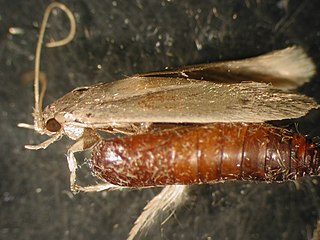
Opogona sacchari, the banana moth, is a moth of the family Tineidae. The species was first described by Wenceslas Bojer in 1856. It is native to the humid tropical and subtropical regions of sub-Saharan Africa, where it is also found in Madagascar, Mauritius, Réunion, Rodrigues Island, the Seychelles and St. Helena. It was first reported from the Canary Islands in the 1920s. In the 1970s, it was introduced into Brazil and Central America, and also appeared in Europe. It has been reported from Florida since 1986.
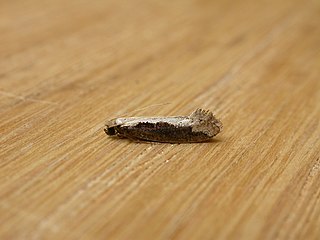
Erechthias diaphora is a moth of the family Tineidae. It is known from Australia, including New South Wales, Queensland and Victoria.

Stathmopolitis is a genus of moths belonging to the family Tineidae. It is the only genus of the Stathmopolitinae subfamily and contains only one species, Stathmopolitis tragocoprella, which is found on the Canary Islands.

Erechthias grayi is a moth of the family Tineidae. It is endemic to Ascension Island.

Erechthias darwini is a moth of the family Tineidae. It is endemic to St. Paul’s Rocks, a group of 15 small islets and rocks in the central equatorial Atlantic Ocean. It was first recorded by Charles Darwin.

Erechthias dracaenura is a moth of the family Tineidae. It is endemic to São Tomé Island, an island off the western equatorial coast of Central Africa. The species was described by Edward Meyrick in 1934.
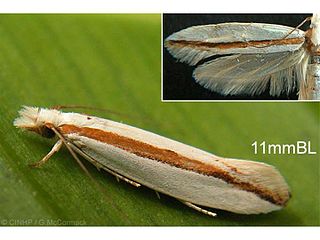
Erechthias psammaula, the brown-stripe moth, is a moth of the family Tineidae. It is found on Fiji, French Polynesia, Tonga and the Cook Islands.

Philonome nigrescens is a species of moth of the family Tineidae. It is found in the south-western United States, where it has been recorded from Arizona and New Mexico.

Philonome curvilineata is a species of moth of the family Tineidae. It is found in French Guiana.
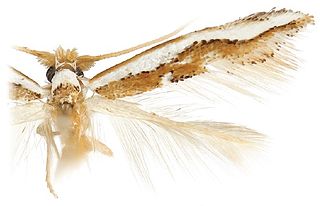
Philonome euryarga is a species of moth of the family Tineidae. It is found in Guyana and French Guiana.
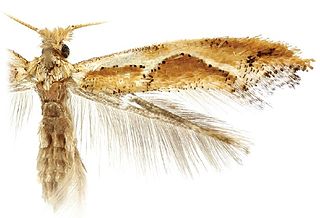
Philonome kawakitai is a species of moth of the family Tineidae first described by Jae-Cheon Sohn, Donald Davis and Carlos Lopez-Vaamonde in 2015. It is found in French Guiana.

Philonome spectata is a species of moth of the family Tineidae. It is found in Brazil (Pará).
Erechthias beeblebroxi is a moth of the family Tineidae. It is endemic to Australia, where it has been recorded from Queensland.

Erechthias indicans is a species of moth in the family Tineidae. It was first described by Edward Meyrick in 1923. This species is endemic to New Zealand and has been observed in Wellington in January.















